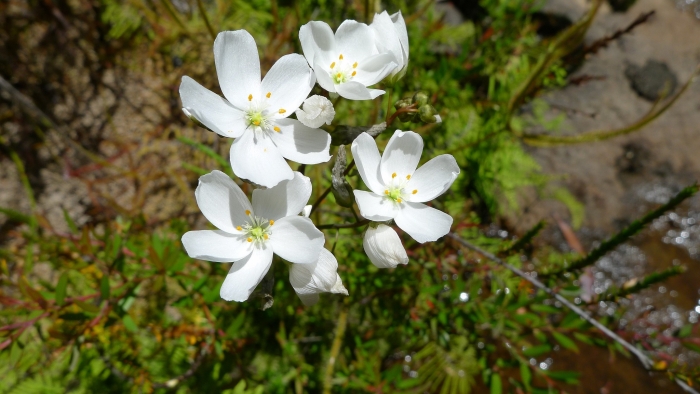Forked Sundew
(Drosera binata)
Forked Sundew (Drosera binata)
/
/

John Tann
CC BY 2.0
Image By:
John Tann
Recorded By:
Copyright:
CC BY 2.0
Copyright Notice:
Photo by: John Tann | License Type: CC BY 2.0 | License URL: https://creativecommons.org/licenses/by/2.0/ | Uploader: John Tann | Publisher: Flickr |






















































Estimated Native Range
Summary
Drosera binata, commonly known as Forked Sundew, is an evergreen perennial herb native to a variety of habitats including bogs, wet heathlands, and margins of forests in Australasia, particularly in Australia and New Zealand. It is a distinctive carnivorous plant, recognized by its narrow, branching leaves that form a "forked" appearance. The leaves are covered with sticky, glandular hairs that trap and digest insects. Drosera binata can reach up to 30 cm (12 in) in height and its foliage, which starts green, often becomes redder with age, especially under direct sunlight. The plant produces small, white flowers during the summer, which are not particularly showy but add to its unique appearance.
Forked Sundew is valued for its intriguing insect-trapping mechanism and is often grown by carnivorous plant enthusiasts. It provides an ecological benefit by controlling insect populations. In cultivation, it requires conditions that mimic its native boggy habitats—high humidity, consistently moist acidic soils, and partial shade to full sun. While it thrives in wet conditions, it is important to avoid waterlogged soil to prevent root rot. Forked Sundew is not typically used in conventional landscaping but is a fascinating addition to water gardens, bog gardens, or as a potted specimen on sunny windowsills. It is relatively low-maintenance, provided its specific water and light needs are met. Some forms of Drosera binata are known to be genetically stable, meaning they maintain their characteristics well over time.CC BY-SA 4.0
Forked Sundew is valued for its intriguing insect-trapping mechanism and is often grown by carnivorous plant enthusiasts. It provides an ecological benefit by controlling insect populations. In cultivation, it requires conditions that mimic its native boggy habitats—high humidity, consistently moist acidic soils, and partial shade to full sun. While it thrives in wet conditions, it is important to avoid waterlogged soil to prevent root rot. Forked Sundew is not typically used in conventional landscaping but is a fascinating addition to water gardens, bog gardens, or as a potted specimen on sunny windowsills. It is relatively low-maintenance, provided its specific water and light needs are met. Some forms of Drosera binata are known to be genetically stable, meaning they maintain their characteristics well over time.CC BY-SA 4.0
Plant Description
- Plant Type: Herb
- Height: 1-2 feet
- Width: 1-2 feet
- Growth Rate: Moderate
- Flower Color: White
- Flowering Season: Summer
- Leaf Retention: Evergreen
Growth Requirements
- Sun: Part Shade
- Water: High
- Drainage: Fast
Common Uses
Showy Flowers, Water Garden
Natural Habitat
Bogs, wet heathlands, and margins of forests in Australasia
Other Names
Common Names: Spoonleaf Sundew, Fork-Leaved Sundew
Scientific Names: , Drosera binata, Drosera dichotoma, Drosera binata var. dichotoma, Drosera pedata, Drosera binata var. multifida, Dismophyla binata, Drosera binata subsp. multifida, Drosera binata subsp. pedata, Drosera binata var. rubra
GBIF Accepted Name: Drosera binata Labill.